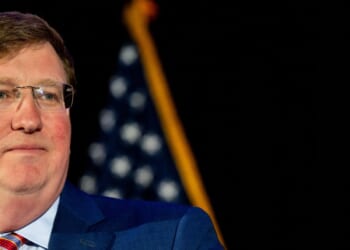Donald Trump’s draft executive order pushes a nuclear strategy focused on deregulation and deployment, but lacks solutions for financing and global partnerships.
The Trump administration has correctly identified Russia and China as the main impediments to its goal of dominating global nuclear energy in the twenty-first century.
Now that it has made this diagnosis, it needs an effective remedy. But if a leak of the administration’s strategy is any indication, its medicine won’t work. It’s over-focused on regulatory reform and under-committed to overcoming private sector financing fears.
The problem the administration faces begins at home. A draft executive order (EO) on “Ushering In a Nuclear Renaissance” notes that “87 percent of nuclear reactors installed worldwide since 2017 are based on Russian and Chinese designs.”
But there are no nuclear power reactors under construction in the United States and no prospect of that changing in the near term. Supply chains have withered, and workforces have thinned. Utilities are gun-shy because of the massive cost overruns and delays at the Vogtle plants in Georgia.
Without a resurgence of deployment at home, there is little chance of domination abroad. You can’t fight something with nothing.
The AI Energy Opportunity
The main driver of projected U.S. energy demand is artificial intelligence (AI) data centers. The administration has made winning the AI race against China a top priority, and Department of the Interior Secretary Doug Burgum has stated that losing the AI race to China is an “existential threat” to the United States.
The administration has created a “National Energy Dominance Council” to ensure the availability of the power necessary to win the AI race. Small nuclear reactors have received attention and financing from AI hyperscalers as a possible solution to their intensive energy needs.
However, President Trump’s nuclear and fossil energy objectives are in conflict with this opportunity.
Powering AI with American natural gas is cheaper and faster than nuclear energy. And with the administration eliminating carbon reduction objectives, there is not a strong incentive to transition between power technologies, despite the hope that gas will serve as a bridge to nuclear-powered AI.
What the Executive Orders Get Right
There are several promising ideas in the Trump draft executive orders for jump-starting U.S. nuclear energy deployment.
One is using federal land and Department of Defense (DoD) funding to build small reactors that can power AI data centers as part of “defense critical infrastructure.” The Army and Air Force are aggressively pursuing small reactors for military installation power and other potential applications. Framing AI as an “existential threat” to national security dovetails with the DoD’s mission.
Another is rebuilding U.S. supply chains for uranium enrichment and the production of new fuels that small reactors will require. A push in this direction was begun under the Biden administration, but the results to date have been meager. With the U.S. ban on Russian nuclear fuel imports looming, American and allied nuclear fuel production must be boosted to compensate for the loss.
Targeting Nuclear Oversight
Yet, a key objective of the executive orders seems to be an obsession with streamlining the Nuclear Regulatory Commission (NRC) and its function of approving reactors for deployment. This is necessary at some level, but also presents risks.
In an interview with the New York Times, Stephen Miran, the chair of Trump’s Council of Economic Advisors, made clear that rolling back regulations was a central objective for the administration. He said, “Regulations throughout the economy hold back firms from producing what they could in order to increase supply … And that’s why the Trump administration is engaging in a whole-of-government deregulation drive.”
Reports about the coming nuclear power executive orders make clear that America’s nuclear regulator is in the administration’s crosshairs.
At a recent Capitol Hill hearing, Department of Energy (DOE) Secretary Chris Wright stated that regulatory actions by the administration will be designed to bring in billions of dollars in private capital, “mostly from hyperscalers” who have expressed interest in smaller reactors under development.
A February Executive Order has already proclaimed White House control over “independent regulatory agencies” like the NRC. It ordered all “so-called ‘independent regulatory agencies’” to “submit for review all proposed and final significant regulatory actions…before publication in the Federal Register.”
Congress has also instructed the NRC to create a technology-neutral approach to achieving its safety objectives in order to accommodate new reactor coolants, including molten salt and gas.
The NRC is acting on this direction and working with over two dozen different reactor vendors and unique fuel cycles to position them for approval. But it is still not well-positioned to effectively assess numerous different exotic fuel cycles and designs.
It is not clear what the Trump administration’s EO will require beyond the already mandated evolution in the NRC’s rulemaking approach. Even a significant additional streamlining of the NRC process is unlikely to make small modular reactors (SMRs) and advanced reactors available before a 2030 timeframe, based on fuel availability and technology timelines.
Federal Workaround and Public Trust
Demonstrating new reactor technologies on federal land seems to be the primary workaround to promote small reactor deployment, as that process may circumvent the need for NRC approval. But it is unclear whether a demo reactor on DOE or DoD land will be allowed to sell its power commercially. Congress may need to act on this first.
Also, throwing regulatory caution to the wind can pose a danger to the overall nuclear renaissance the administration is trying to push forward. Public confidence is critical to deployment at scale, and one accident can kill global nuclear energy momentum, as was the case with Three Mile Island and Fukushima.
Boosting the Large Reactor Market
Aside from creating a pathway for small reactors to be demonstrated on federal land, it is unclear where the commercial drive for large reactor expansion in America will come from.
Some retired reactors are getting new life at Three Mile Island in Pennsylvania and Palisades in Michigan.
Then there are the two partially complete Westinghouse AP-1000 reactors in South Carolina at the Virgil C. Summer (V.C.) Nuclear Power Station. The Santee-Cooper utility is evaluating how to proceed on this project, including potentially selling it to another entity to complete. The reactors have been mothballed for eight years, after an investment of four years and $9 billion.
How the V.C. Summer project plays out could influence whether other utilities jump back into the nuclear power pool.
However, not many have expressed enthusiasm for a $20 billion investment in new nuclear reactors when greenhouse gas mandates are melting away and natural gas is much cheaper.
So, this is where the administration will need to determine how to incentivize private capital to take on the risk of nuclear energy deployment at scale.
The Budget Doesn’t Match the Mission
One of the reasons Secretary Wright was on the Hill was to defend the administration’s proposed budget, which includes a $400 million cut to the DOE Office of Nuclear Energy’s “non-essential research on nuclear energy.” But cutting the nuclear energy budget, rather than redirecting these funds toward deployment goals, seems incongruous with the administration’s energy dominance goals.
Wright did testify to the House Energy and Water Appropriations Subcommittee that DOE will continue the Loan Programs Office (LPO) to support nuclear power projects. LPO has committed $1.5 billion in guarantees for the Palisades reactor restart project. But there is nothing beyond that commitment.
Global Partners Could be the Missing Piece
If the administration intends to move private finance from virtue signaling support for nuclear expansion to actual deployment commitments, it is going to have to get more creative.
For example, it is now possible to partner with foreign allies on nuclear projects in the United States. A South Korea-U.S. partnership (KORUS) could bring into play not just Korean financial support but also petro-state financing from the Middle East. Korea has cultivated nuclear energy engagement with both the United Arab Emirates (UAE) and Saudi Arabia. And Korea and the UAE have agreed to pursue “joint nuclear power projects abroad.” Any U.S.-Saudi reactor deal will necessarily include Korea, accelerating the potential for a U.S.-South Korea-Persian Gulf nuclear alliance.
This approach could reduce the required U.S. financial commitment to push forward domestic deployment of large and small reactors.
Further, the administration needs to guide the rapidly approaching congressional reauthorization of the Development Finance Corporation and the Export-Import Bank. These organizations are supporting nuclear projects in Poland and Romania, but under current legislation, neither has sufficient funds to finance U.S. nuclear exports abroad at scale. Both of these agencies should be provided greater flexibility and financing to become strong weapons in nuclear exports.
The Bottom Line
The Trump administration rightly sees Russia and China as its main competitors in the fight for global nuclear market share. And the only way to win that fight is to deploy American technology. Its pending executive orders provide greater clarity regarding its potential solution set. But the proposed approach so far is likely too narrow. While regulatory relaxation will be important, firm commitments for the future from private finance and foreign allies are essential. And that needs more urgent and creative attention.
About the Author: Kenneth Luongo
Kenneth N. Luongo is the president and founder of the Partnership for Global Security (PGS) and the Center for a Secure Nuclear Future.
Image: Anton Watman/Shutterstock
















